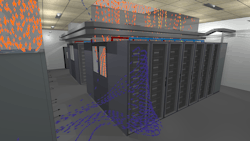Exploring Liquid Cooling and Digital Twin Technology in Today's Data Centers
The need for efficient data centers continues to grow as the world becomes increasingly digitalized. While heat has always been a significant challenge for data centers, liquid cooling and digital twins offer remarkable solutions to continue delivering energy efficiency in a world with changing IT technology.
Liquid Cooling: The Future of Modern Cooling Systems
Data centers contain powerful components that generate a lot of heat. The traditional remedy has been air cooling, but this method often struggles to keep up with growing heat densities in servers and racks. On the other hand, liquid cooling, which uses fluid substances like water-based coolants to absorb heat, shows great promise.
Water, for instance, can hold about 4.2 times more heat per kilogram than air and can store around 3,500 times more energy per volume. This ensures that even tiny amounts can be pumped around high-powered components to remove heat efficiently.
Liquid cooling boosts power densities that can be cooled, effectively recovering heat while consuming less energy than air cooling. It’s a vital solution for avoiding overheating and performance issues, and it’s particularly effective for high-density server racks when loads exceed around 20kW per rack.
Braving the Challenges of Direct-to-Chip Liquid Cooling and Immersion Cooling in Data Centers
There are fundamentally two approaches to liquid cooling: direct-to-chip cooling, where liquid is directed to cold plates on the hot components (such as CPUs, GPUs, and memory), and immersion cooling, where the whole IT system is immersed in liquid.
Although liquid cooling presents a host of benefits, it also has challenges. Electrical risks, though much reduced thanks to dripless quick connectors and negative pressure systems, are still a primary concern for operators.
In addition, integrating liquid cooling in data centers that already use air cooling can be tricky. Both systems must operate well together to ensure efficiency, which usually involves coordinating complex logistics and significant investments.
Immersion cooling adds extra complications, but it offers the potential of even more of the heat being captured by the fluid than with direct-to-chip liquid cooling. Concerns about material compatibility and the impact of increasing power demands on natural flow effectiveness need to be addressed.
Modern Data Centers Need Digital Twins
Digital twins—virtual models of data centers—can help designers and operators plan to cool their facilities optimally. With this technology, they can evaluate options and validate the best proposals through simulations that predict the facility outcomes.
Operators can evaluate the advantages and disadvantages of different cooling strategies and test multiple deployment scenarios. When connected to environmental monitoring systems and similar technologies, digital twins evolve alongside their physical counterparts, enabling continuous identification of improvement opportunities.
They can evaluate the impact of new hardware or denser servers on the cooling system, helping to prevent issues such as slow IT performance and lost capacity. When powered by a physics-based simulation engine, a digital twin can simulate cooling and airflow, showing how these factors fluctuate with each deployment.
Given the dynamic nature of data centers, understanding how equipment responds to new setups is crucial for effectively meeting growing demands and budgeting. Digital twins enable teams to explore numerous scenarios, maximizing capacity while minimizing risks, which is vital for energy efficiency and reducing carbon footprints.
Implementing Liquid Cooling Using Digital Twin Technology
Liquid cooling has the potential to revolutionize modern data centers. By effectively handling heat through direct-to-chip and immersion cooling, data centers can achieve high efficiency and reliability.
Introducing digital twins into the mix further aids decision-making, enabling operators to tailor cooling strategies to their needs. Digital twins empower stakeholders to evaluate all options, predict outcomes, and make informed decisions to prepare their data centers for future changes, such as deploying previously unconsidered higher power densities associated with AI without incurring risks.
While there are hurdles to clear, advancements in technology and practices are creating a pathway for broader adoption. As the demand for data processing continues to soar, the role of liquid cooling and digital twins becomes increasingly crucial in maintaining performance and sustainability in the ever-evolving field of data centers.
About the Author

Mark Seymour
Mark Seymour is a Distinguished Engineer at Cadence, where he leverages his entrepreneurial and technical expertise of 30+ years in the field to develop its products and services. Previously, he co-founded and served as Chief Technology Officer at Future Facilities, driving its growth and innovation before its acquisition.
Cadence is a pivotal leader in electronic systems design, building upon more than 30 years of computational software expertise. The company applies its underlying Intelligent System Design strategy to deliver software, hardware, and IP that turn design concepts into reality. Cadence acquired Future Facilities in 2022 for its expert 6SigmaDCX and 6SigmaET simulation software suites to expand its electronics product portfolio and facilitate energy efficiency and performance optimization for the data center industry through digital twin technology – now Cadence Reality DC.



